AI in Medical Imaging Market Overview
The global AI in medical imaging market was valued at USD 1.9 billion in 2022 and is projected to reach USD 29.8 billion by 2032, growing at a CAGR of 32.1% from 2023 to 2032.
The artificial intelligence in medical imaging market provides a disruptive junction of artificial intelligence and healthcare diagnostics that is set to revolutionize medical imaging practices. This booming industry aspires to take healthcare diagnostics and patient outcomes to unprecedented heights by seamlessly integrating modern AI algorithms with existing medical imaging modalities such as X-ray, CT, MRI, and ultrasound. AI-powered medical imaging solutions cover a wide variety of applications, such as image analysis, illness diagnosis, picture reconstruction, segmentation, and workflow optimization. These apps attempt to improve the accuracy, speed, and efficiency of medical picture interpretation, allowing for the early identification and exact diagnosis of a variety of medical diseases.
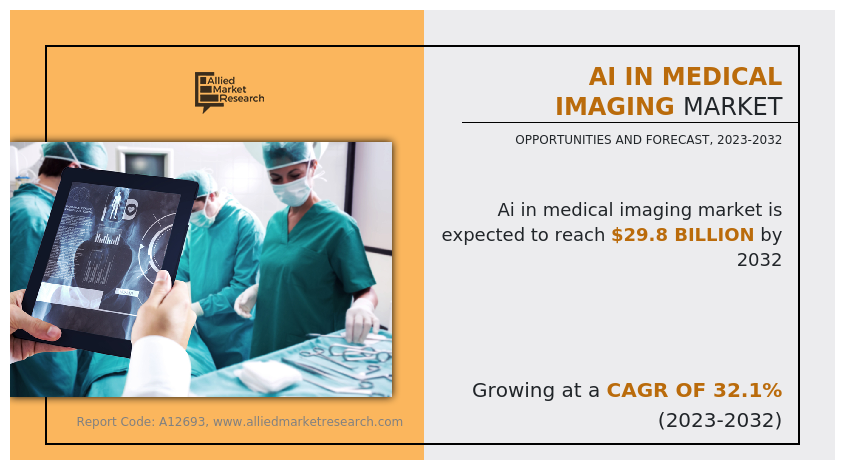
AI in medical imaging industry has the potential to greatly assist healthcare practitioners and organizations. AI-enabled technologies help radiologists spot minor irregularities and trends, minimizing the possibility of error and improving diagnosis accuracy. Furthermore, these tools expedite operations, allowing radiologists to focus on complex situations requiring human experience. As AI advances in the medical imaging market, issues such as data privacy, regulatory compliance, and interoperability remain critical considerations.
Finding the correct balance between utilizing AI's promise and adhering to ethical and regulatory norms will be critical in realizing the market's full potential. The artificial intelligence in medical imaging market offers a paradigm change in healthcare diagnosis. Its disruptive influence has the potential to empower medical practitioners, improve patient care, and redefine the landscape of medical imaging practices. As AI technologies progress and healthcare players embrace innovation, the future of this dynamic business holds amazing possibilities for growth and transformation.
Several factors are driving the AI in medical imaging market, with one of them being the increasing use of AI in radiology. AI's capacity to quickly and accurately analyze medical pictures has improved diagnostic capabilities and shortened procedures. AI-assisted image interpretation benefits radiologists by assisting in the detection of minor anomalies, early illness diagnosis, and personalized therapy planning. AI systems can quickly spot patterns and abnormalities that human eyes may otherwise overlook by sorting through enormous volumes of image data. This has led to better patient outcomes, a reduction in diagnostic blunders, and optimal resource use.
Another driving factor is the rise in demand for AI-powered CT. A tremendous increase in demand for AI-powered Computed Tomography (CT) has been seen in recent years, driven by the technology's revolutionary effects on diagnostics and healthcare. The quality and effectiveness of medical imaging have been revolutionized by AI integration with CT technology, resulting in more accurate diagnoses, early illness diagnosis, and personalized treatment strategies. Radiologists and physicians are now able to spot minor irregularities, complex tissue structures, and possible problems that could have gone unnoticed using conventional techniques thanks to AI algorithms that analyze CT images with unmatched speed and precision.
On the other hand, the rise in costs is hampering the market. The market for AI in medical imaging has been significantly constrained by the rising cost of implementation. While AI has shown incredible promise in improving patient care, treatment planning, and diagnostic accuracy, its adoption comes with a hefty price tag that presents difficulties for healthcare organizations and providers. Complex procedures including data gathering, algorithm development, and hardware procurement are required for the integration of AI into medical imaging.
Separately, the increase in product approvals and more funding received from AI companies presents significant opportunities for the market. The AI in medical imaging market offers a sizable opportunity for expansion, driven by rising product
approvals and investments made in partnerships with AI enterprises. Modern artificial intelligence technology and medical imaging have the potential to transform the quality of patient care, diagnostic accuracy, and overall healthcare outcomes. The widespread use of AI-driven imaging systems is prompted by these approvals, which provide healthcare practitioners more confidence. In addition, strategic alliances and financial investments with AI companies are crucial in advancing market penetration.
Segment Overview
The AI in medical imaging market size is segmented on the basis of modality, technology, application, industry vertical and region.
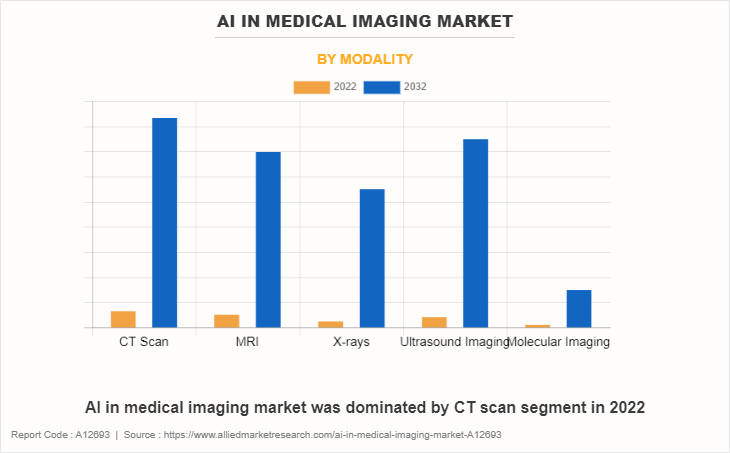
In terms of market segmentation by modality, the AI in medical imaging market was dominated by CT Scan segment in 2022, whereas the X-rays segment is expected to witness a higher growth rate during the forecast period. A common medical imaging method called a CT (Computed Tomography) scan uses X-rays and computer processing to produce cross-sectional pictures of the body. Numerous medical diseases are diagnosed, planned for therapy, and monitored using these pictures. A significant advancement in radiology has been the integration of AI (Artificial Intelligence) in medical imaging, particularly CT scans.
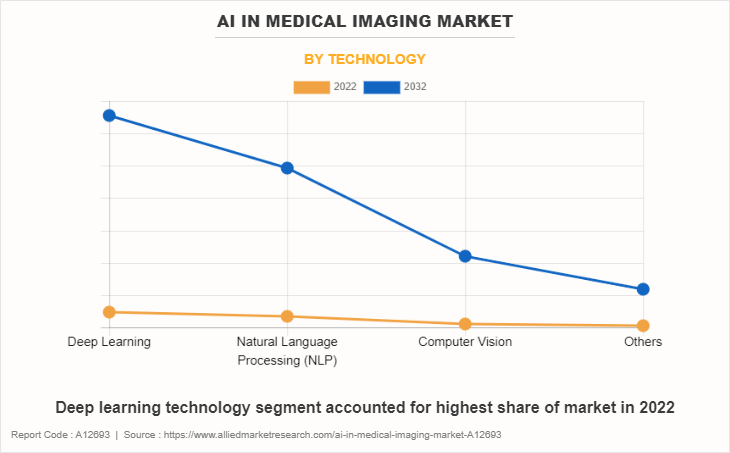
In terms of market segmentation by technology, the AI in medical imaging market was dominated by deep learning segment in 2022, whereas the computer vision segment is expected to witness a higher growth rate during the forecast period. Deep learning in AI has had an immense effect on the medical imaging sector owing to its ability to improve the precision of diagnostics, automate image processing, and assist the early diagnosis of disease. Applications can be found, among other fields of medicine, in radiology, pathology, ophthalmology, cardiology, and neurology.
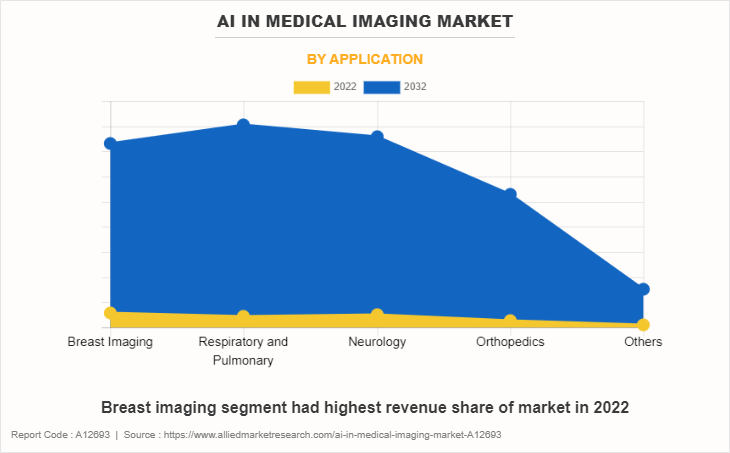
In terms of market segmentation by application, the AI in medical imaging market was dominated by the breast imaging segment in 2022, whereas the orthopedics segment is expected to witness a higher growth rate during the forecast period. Breast imaging applications in AI within the medical imaging market encompass a range of technologies and techniques that utilize artificial intelligence to assist in the analysis, interpretation, and management of breastrelated medical images. In specifically for the identification and diagnosis of breast disorders such as breast cancer, these applications seek to increase the precision, effectiveness, and general quality of breast imaging processes.
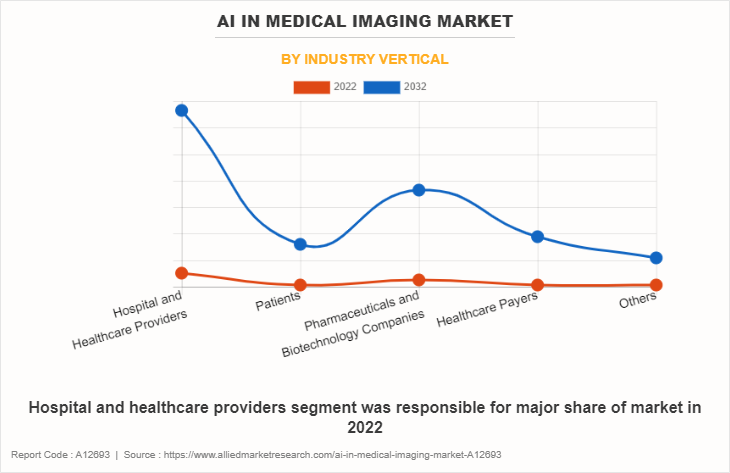
In terms of market segmentation by industry vertical, the AI in medical imaging market was dominated by the hospital and healthcare providers segment in 2022, whereas the patients segment is expected to witness a higher growth rate during the forecast period. The landscape of hospitals and healthcare providers has been completely transformed by the incorporation of AI in medical imaging. This developing industry makes use of cutting-edge algorithms to boost diagnostic precision, simplify processes, and better patient outcomes. AI-driven image analysis speeds up the identification of abnormalities in radiology, pathology, and other fields, enabling medical personnel to act quickly and with knowledge. The convergence of technology and healthcare is continuing to alter the sector, offering more accurate and efficient medical imaging diagnostics for a healthier future as hospitals embrace AI-driven solutions at an increasing rate.
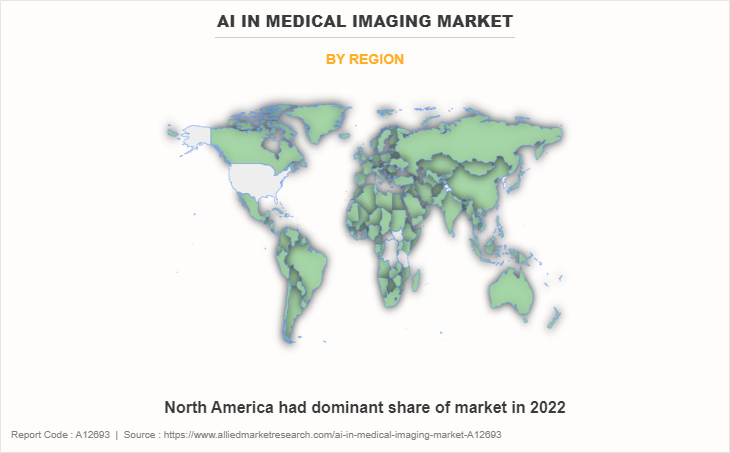
In terms of region, the AI in medical imaging market was dominated by North America in 2022, while Asia-Pacific is anticipated to expand at a faster rate during the forecast period. Modern deep learning and machine learning techniques are the foundation of the North American industry for artificial intelligence in medical imaging, which is revolutionizing diagnoses. The industry is ready to grow, using cutting-edge healthcare infrastructure, regulatory backing, cooperative collaborations, broad datasets, and education investments to realize the full potential of AI in diagnosis and patient care.
Top Impacting Factors
AI integration in medical imaging has the potential to greatly assist healthcare practitioners and organizations. AI-enabled technologies help radiologists spot minor irregularities and trends, minimizing the possibility of error and improving diagnosis accuracy. Furthermore, these tools expedite operations, allowing radiologists to focus on complex situations requiring human experience. As AI advances in the medical imaging market, issues such as data privacy, regulatory compliance, and interoperability remain critical considerations.
Finding the correct balance between utilizing AI's promise and adhering to ethical and regulatory norms will be critical in realizing the market's full potential. The market for artificial intelligence in medical imaging offers a paradigm change in healthcare diagnosis. Its disruptive influence has the potential to empower medical practitioners, improve patient care, and redefine the landscape of medical imaging practices. As AI technologies progress and healthcare players embrace innovation, the future of this dynamic business holds amazing possibilities for growth and transformation.
Key Market Players
Competitive analysis and profiles of the major players in AI in medical imaging industry that have been provided in the report include Siemens, NVIDIA Corporation, IBM Corporation, GE Healthcare, Koninklijke Philips N.V., Aidoc, Butterfly Network, Inc., Zebra Technologies Corp., Arterys Inc., and ICAD Inc. These key players have adopted several strategies such as new product launches and development, acquisition, partnership, and collaboration and business expansion to increase their market share in the global AI in medical imaging market forecast.
Key Developments/Strategies:
In Jane 2023, GE Healthcare announced that its new deep learning (DL) technology would reduce the time required for an MRI. cutting-edge picture acquisition accelerator, known as Sonic DL, may cut scan times by as much as 83% and even catch the motion of a single cardiac contraction in real-time.
In November 2022, In order to offer better patient care at reduced costs, Nuance Communications, Inc. and NVIDIA announced a partnership that for the first time places AI-based diagnostic tools in the hands of radiologists and other clinicians at scale.
Key Benefits for Stakeholders:
This report provides a quantitative analysis of the market segments, current trends, estimations, and dynamics of the AI in medical imaging market analysis from 2022 to 2032 to identify the prevailing AI in medical imaging market growth.
The AI in medical imaging market research is offered along with information related to key drivers, restraints, and opportunities.
Porter's five forces analysis highlights the potency of buyers and suppliers to enable stakeholders make profit-oriented business decisions and strengthen their supplier-buyer network.
In-depth analysis of the AI in medical imaging market share assists to determine the prevailing AI in medical imaging market opportunities.
Major countries in each region are mapped according to their revenue contribution to the global AI in medical imaging market.
Market player positioning facilitates benchmarking and provides a clear understanding of the present position of the market players.
The report includes the analysis of the regional as well as global AI in medical imaging market trends, key players, market segments, application areas, and market growth strategies.
AI in Medical Imaging Market Report Highlights
| Aspects | Details |
| Market Size By 2032 | USD 29.8 billion |
| Growth Rate | CAGR of 32.1% |
| Forecast period | 2022 - 2032 |
| Report Pages | 330 |
| By Modality |
|
| By Technology |
|
| By Application |
|
| By Industry Vertical |
|
| By Region |
|
| Key Market Players | GE Healthcare, Arterys Inc., IBM Corporation, NVIDIA Corporation, Koninklijke Philips N.V., Siemens, Aidoc, Zebra Technologies Corp., Butterfly Network, Inc., ICAD INC. |
Analyst Review
The AI in medical imaging market is highly competitive, owing to strong presence of existing vendors. The concerned vendors, who have access to extensive technical and financial resources, are anticipated to gain a competitive edge over their rivals as they have the capacity to cater to the global market requirements. The competitive environment in the market is expected to further intensify with increase in technological innovations, product extensions, and different strategies adopted by key vendors.
This optimistic prognosis was powered by the rise in demand for AI in several medical devices. In addition, the market optimism was aided by newly developed applications in the healthcare sector. Market interest in current technical developments in the concerned market was high. To enhance the performance, flexibility, and durability of the technology, producers and researchers were always looking into new innovations. This ongoing innovation was viewed as an indication of potential future growth.
The market growth is supplemented by proactive surge in AI powered medical solutions, owing to technological advancements. These factors have allowed emerging markets to evolve as largest markets during the forecast period, both from the demand as well as the supply side. Public & private organizations have substantially invested in R&D activities and fabrication techniques to develop cost-effective AI in medical imaging. North America is the major revenue contributor to the global market, followed by Europe. The market growth in AsiaPacific is expected to significantly increase during the forecast period. The AI in medical imaging market provides numerous growth opportunities to the market players such as Siemens, NVIDIA Corporation, IBM Corporation, GE Healthcare, Koninklijke Philips N.V., Aidoc, Butterfly Network, Inc., Zebra Technologies Corp., Arterys Inc., and ICAD Inc., and others. These companies are engaged in the process of product innovation, collaboration, and acquisition to expand their services across various regions.
The market was estimated at US$ 1.8 Billion in 2022 and is forecast to reach US$ 29.75 Billion in 2032.
The CT scan segment was the leading modality in AI in medical imaging market in 2022
The breast imaging segment was the leading application in AI in medical imaging market in 2022
North America was the leading region in AI in medical imaging market in 2022
The top companies are Siemens, NVIDIA Corporation, IBM Corporation, GE Healthcare, Koninklijke Philips N.V., Aidoc, Butterfly Network, Inc., Zebra Technologies Corp., Arterys Inc., and ICAD Inc.
Loading Table Of Content...
Loading Research Methodology...



